Restorative Dentistry Eugene
Renewing Your Smile’s Strength & Function
Restoring your teeth following decay or damage is important to your oral health. Our staff at College Hill Dental can fix damage and replace missing teeth while improving your ability to chew properly and may even improve your speech. If you are experiencing tooth pain, discomfort, or are only chewing on the other side, we can help with restorative dentistry in Eugene.
Why Choose College Hill Dental for Restorative Dentistry?
- Multiple Sedation Dentistry Options Available
- In-Network with Many Leading Dental Insurance Providers
- Same-Day Emergency Dental Appointments
Tooth-Colored Fillings
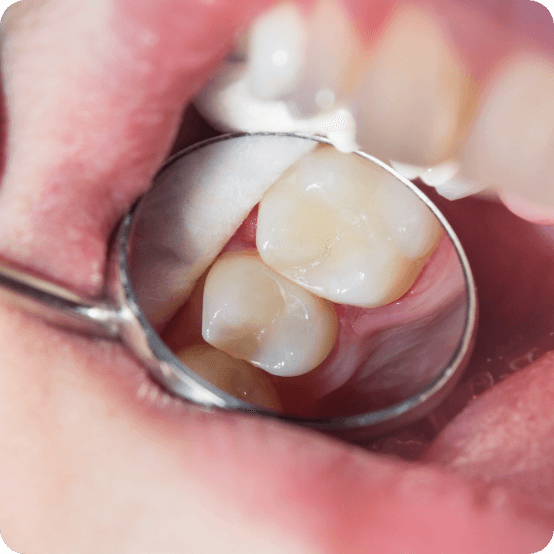
While traditional cavity fillings are made from dark metal amalgam and stand out when you smile, tooth-colored fillings are – as the name implies – designed to blend in seamlessly with your pearly whites. They’re made from composite resin, a putty-like material that can be shaded to match the color of your tooth enamel. Unlike metal, the resin can chemically bond with your tooth, which means we don’t need to remove as much – or any – natural tooth structure in order to place the filling. Ultimately, tooth-colored fillings are the healthier and cosmetically superior way to repair decayed teeth.
Dental Crowns

A dental crown is a treatment provided to help restore teeth affected by damage. It is a cap-like restoration that is designed to encase the entire visible surface of the affected tooth. It works to hold the damaged tooth together, preventing further damage and infection, while also restoring its strength so that it can function normally.
Your teeth perform some essential tasks every day. They are incredibly strong, able to stand up a significant amount of daily use. Despite their incredible strength, the teeth can still be affected by physical damage and decay, which can lead to cracks, chips, cavities, and more. This damage can compromise the strength of the affected teeth as well as their health. At College Hill Dental, we can restore the health and strength of a damaged tooth with a dental crown.
What Is a Dental Crown?
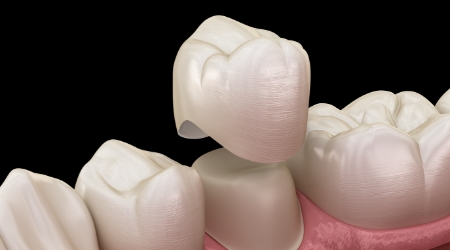
When faced with tooth damage, it is essential to get treatment right away, even if the damage does not seem all that serious at the time. Tooth damage can worsen over time. More significant damage can compromise the strength of the tooth and leave it susceptible to developing an infection. A dental crown is a treatment provided to help restore teeth affected by damage. It is a cap-like restoration that is designed to encase the entire visible surface of the affected tooth. It works to hold the damaged tooth together, preventing further damage and infection, while also restoring its strength so that it can function normally.
Dental Crown Materials
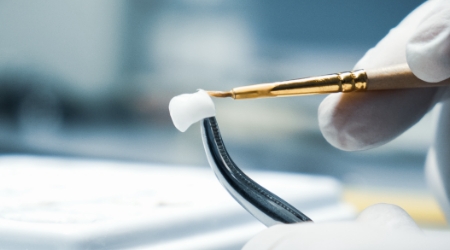
A dental crown can be made from one of several different materials. These include:
- Metal. A metal dental crown is the strongest type of crown available. It is practically indestructible and can last 50 years or longer with proper care. Despite its incredible strength, metal crowns are silver or gold in color. They stand out quite prominently against the rest of your teeth, making it obvious.
- Porcelain fused to metal. Porcelain fused to metal, or PFM, dental crowns combine the strength of metal with the aesthetics of porcelain. The crown has a metal base that surrounds your tooth. A porcelain coating helps to provide a more natural appearance. In some cases, the metal can be seen through the porcelain, rendering them more noticeable.
- Ceramic. Ceramic dental crowns are the most aesthetically pleasing option available. They are made entirely from ceramic, a material that can be stained to perfectly match the color of your natural teeth. It also reflects light just like natural tooth enamel. It may not be as strong as metal, but it can still withstand most normal daily use.
Reasons to Get a Dental Crown
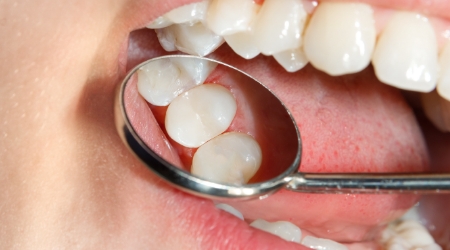
There are several benefits associated with getting a dental crown. These benefits include
- Prevention of further damage.
- Protection against infection.
- Restoring strength and allowing the tooth to function normally.
- Preventing the need for a tooth extraction.
Dental crowns also work to anchor a fixed bridge in place, replace missing teeth with dental Implants, and provide additional protection following a root canal.
How Is a Dental Crown Placed?
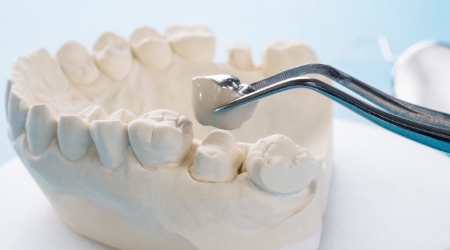
Getting a dental crown typically takes two appointments. During the first appointment, we first prepare the tooth. This is done under a local anesthetic, which ensures that you feel no discomfort. Preparing the tooth involves removing a portion of your tooth enamel to make the tooth smaller. This is necessary for ensuring that your crown will fit comfortably and naturally in with the rest of your teeth. After the tooth has been prepared, we take an impression of your mouth.
The impression is sent to our dental lab, where your custom crown is designed and created. This process can take up to two weeks, so a temporary crown is placed while you wait. The temporary crown helps to protect your tooth while you wait for your final restoration. At your second appointment, after your custom dental crown has been sent back, we check the restoration for fit and bite. If everything looks and feels good, the dental crown is cemented into place on your tooth.
Tooth Extractions

We never take the extraction of a tooth lightly. When possible, we encourage our patients to take steps to save their natural teeth. In the past, dentists and patients extracted teeth as common practice. What they found is that missing teeth caused a cascade of other negative problems. We promote only extracting a tooth when no other option is available. In general, there are two types of tooth extractions: surgical and non-surgical. A non-surgical extraction can quickly turn into a surgical extraction.
Reasons for Tooth Extraction

We may recommend the extraction of a tooth when the patient has the following:
- Malocclusion: At times, an orthodontist may recommend a tooth extraction to improve the bite of the patient. Known in dentistry as a malocclusion, a bad bite can be problematic for a patient, causing conditions such as TMJ dysfunction, bruxism, or cosmetic problems.
- Extra Teeth: At times a patient may have extra teeth competing for the same space. The best course of action in this instance is the removal of one of the teeth. Ideally, this is done before the tooth is problematic to the patient.
- Impacted Teeth: An impacted tooth is a tooth that cannot fully come out of the gum tissue, often due to overcrowding. Impacted teeth are a significantly greater risk of developing an infection because there is space for bacteria to get stuck and hide. Wisdom teeth are often removed because they are impacted.
- Decayed or Damaged Teeth: Teeth that are severely decayed or damaged may require extraction. It is always our first attempt to preserve a tooth when we can, but if there is insufficient tooth structure to adhere a crown, or if the patient has significant bone loss, we may need to extract.
The Tooth Extraction Procedure
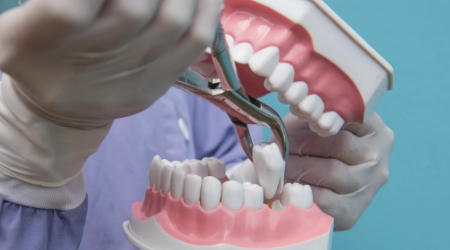
The process of removing a tooth can be categorized as being non-surgical or surgical. Though we will discuss treatment with you before beginning, at times, we may begin a non-surgical extraction that quickly turns into a surgical extraction.
Non-Surgical Tooth Extraction

A non-surgical extraction can be completed on a tooth that is fully extended and intact. This type of extraction means that we can take a pair of forceps and be able to wrap them around the tooth. We will begin with a lever which is used to pull up and lift the tooth from the root and then pull the tooth out with forceps. This process is not the most comfortable, though we will provide a local anesthetic to numb the area to assist with discomfort. The patient will experience a certain amount of bleeding that should stop within a short time. We will review post-treatment care instructions with you before you leave. It is preferred that the patient take it easy for the first 1-2 days following extraction, this is for their comfort and to reduce the incidence of continued bleeding.
Surgical Tooth Extraction
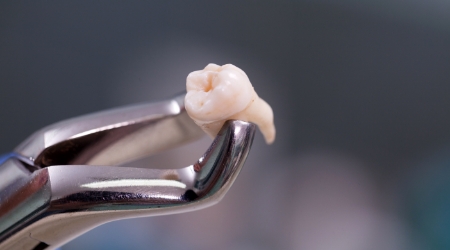
Surgical extraction means that it was necessary to make cuts to retrieve the tooth from the socket. This is done for teeth that are impacted including wisdom teeth, also known as third molars. For some patients, it may be necessary to break, or quarter, the tooth and then remove it in sections. Patients who have a tooth surgically extracted often have a suture placed, this will reduce bleeding, but also means that the patient will need to return for the removal of the suture. We will provide you with care instructions before you leave. There are steps you can take to reduce the chance of developing infection and how to handle any bleeding, including information on excessive bleeding.
Tooth Extraction

Dental Bone Grafts
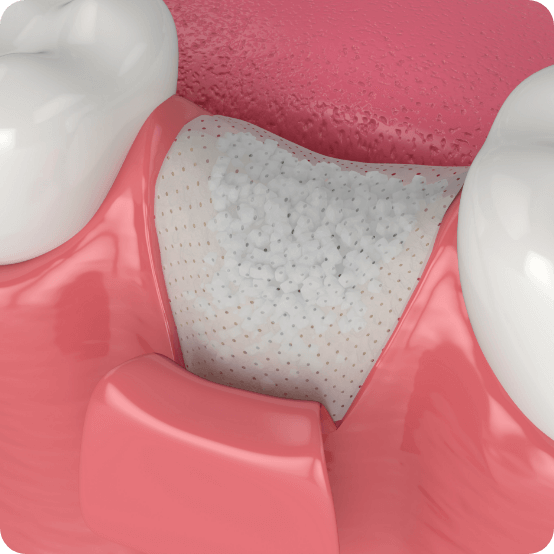
Bone grafting is a surgical procedure that is used to fix problems associated with the bone or joints. It involves transplanting bone tissue, and in the field of dentistry, it is most completed so that there is enough bone available to support dental implants.
A bone that has been attacked by gum disease, or atrophied from tooth loss, can be bulked up through a simple bone graft. This procedure is often done in preparation for restoration. By applying bone fragments to your damaged bone, you can grow new and healthy bone material. Our staff at College Hill Dental can work with you to evaluate, diagnose, discuss, and create a treatment plan to restore your oral health through the restoration of bone health.
Your jawbone is subject to damage whether from infection, atrophy, or trauma. It can lose mass, change the look of your facial shape, be unable to support teeth properly, or cause jaw problems known as TMJ dysfunction which prevents the jaw joint from opening or closing properly.
- Chronic Periodontal Disease: When a patient suffers from chronic periodontal disease, or gum disease, the damage affects both soft and hard tissue. The infection can eat away at the bone, causing large areas of the bone to be pitted or unsupportive of your teeth.
- Atrophy: The loss of a tooth is more than simply a missing tooth; your bone health relies on the movement of teeth to keep it healthy. When a patient loses the tooth root and tooth, the bone responds with immediate atrophy.
- Trauma: Bone loss can occur from trauma, breaks, fractures, and more. Patients who have taken an impact to their jaw should have x-rays done to determine the level of trauma, some injuries can be less obvious.
Dental Bone Graft Surgical Process
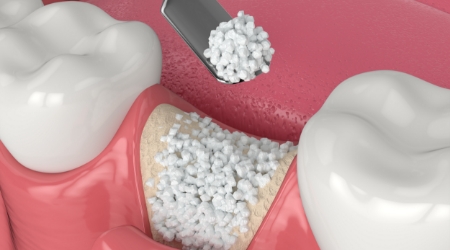
The surgical process for a bone graft procedure is done in our dental office, quickly and easily. We first ensure the patient’s comfort with an anesthetic; a local anesthetic is often all that is necessary. We open the tissue to reveal the bone that needs to be bulked up. We apply a bone material; there are options for bone material that we use. The most used bone fragments include some of the patient’s bone that is harvested from another area. We also can use synthetic bone and donated bone.
We place the bone fragment and then suture the area closed with stitches. The soft gum tissue should heal within a few days, but the bone will require a few months to grow.
Once we have determined that sufficient bone has grown, we can then proceed with the restoration.
Tooth Restorations
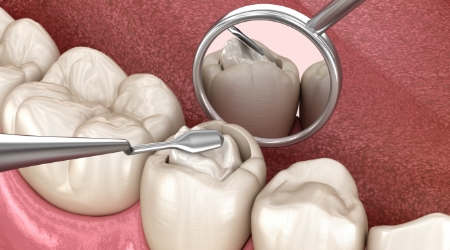
One of the most common restorations performed following a bone graft is the restoration of a tooth with the insertion of a dental implant. Dental implants are metal or acrylic devices that we sink into the bone to replace the root of a missing tooth. The bone will heal around the implant bonding the two together, creating a firm anchor for a dental crown or other prosthetic to then be attached to. The dental implant can also serve as an anchor for other prosthetics including a dental bridge, partial denture, or full denture. Bone health is important to the success of the implant, and a bone graft allows the patient to have a healthy bone.
Root Canal Treatment
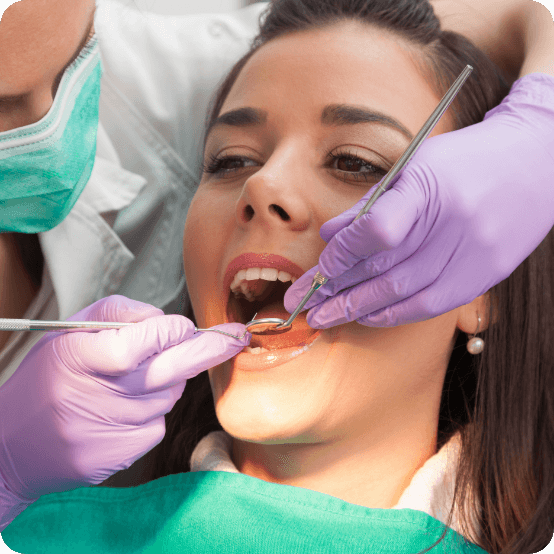
Root canal treatment is a procedure we perform when the inside pulp portion of a tooth has become infected. Though patients often fear the thought of a root canal procedure, it is the infection they should fear more. Your body is incapable of healing from a pulp infection on its own; the infection will only continue to rage until it kills the tooth and possibly spread to neighboring teeth. The only way to keep the tooth and remove the infection is through root canal therapy. We will open the tooth, remove the source of the infection, cleanse the area, and restore the tooth.
A root canal procedure is needed when the inner portion of a tooth has become infected. Though patients never want to hear that it’s needed, infected tooth pulp cannot heal itself. Our team at College Hill Dental can help, we can review the problem, locate the source of the infection, remove the source, and restore the tooth to health. We can help you have a healthy smile, strengthen your teeth and give you a beautiful look.
Why Do I Need a Root Canal?
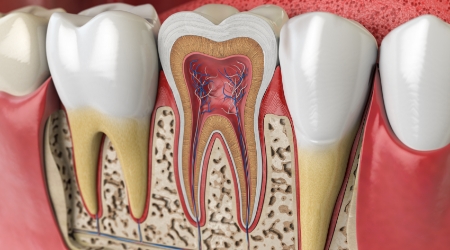
Root canal treatment is needed when bacteria have found a passage to the inner portion of your tooth. This is often due to bacteria creating a deep cavity, but can also occur when the tooth has fractured, tiny cracks in the tooth have formed, or a filling has experienced shrinkage creating space between the filling and tooth.
Some patients may experience dull pain or sensitivity; others may have much more obvious pain, neither should be ignored. An infection inside your tooth will not heal, it will spread in the narrow web of canals to neighboring teeth, destroying your teeth, bone, and gum tissue. The results will be painful and expensive. There are only two options, to remove the infected tooth or to have a root canal procedure.
Removing the infected tooth is a possibility, but not one that we recommend. Missing teeth will cause a cascade of effects, some that are immediately noticeable, and some that will show after years. Missing teeth can cause difficulty in your ability to chew, in your speech, leave room for neighboring teeth to roam in an uncontrolled fashion and result in bone loss. When possible, we always recommend saving the natural tooth structure.
Root Canal Treatment Procedure

A root canal is not painful, as often described, it releases the pain that is already brewing inside. We begin the root canal by providing the patient with a local anesthetic to provide pain relief. Once numb, we then create a space inside the tooth to reach the pulp. We remove all of the inner portion, the pulp, the nerve, and the infected material. When the tooth was growing, this inner pulp was needed, but once the tooth is fully formed, it no longer is. The canal is then cleansed with an antibacterial wash and filled with a medicated rubber material. The tooth is finally sealed with filling material and covered with a dental crown.
Dental crowns are expensive; this is because they are always custom-made and fitted. Having a tooth covered with a dental crown provides the tooth with much-needed strength. With the tooth covered, it is now strong enough to use for regular chewing.
We recommend patients to protect their teeth; this can be done through a regular hygiene routine, along with maintaining a working relationship with our dental office where we can evaluate the status of your teeth and help you catch problems before they become bigger. Having a healthy smile will assist in your overall health along with your comfort and confidence.





